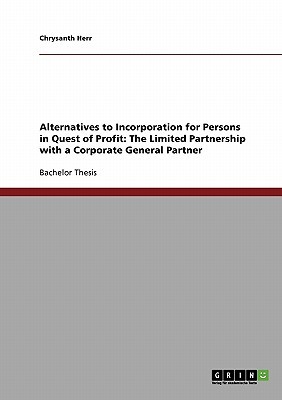
- We will send in 10–14 business days.
- Author: Chrysanth Herr
- Publisher: GRIN Verlag
- Year: 2007
- Pages: 60
- ISBN-10: 3638667359
- ISBN-13: 9783638667357
- Format: 14.8 x 21 x 0.4 cm, minkšti viršeliai
- Language: English
- SAVE -10% with code: EXTRA
Alternatives to Incorporation for Persons in Quest of Profit (e-book) (used book) | bookbook.eu
Reviews
Description
Bachelor Thesis from the year 2006 in the subject Law - Civil / Private / Trade / Anti Trust Law / Business Law, grade: A-, New York University School of Law, course: US corporate and commercial law, language: English, abstract: American company law traditionally offered a group of businessmen in quest of profit only two choices of business associations: a corporation or a partnership. Both forms have their advantages and disadvantages that depend upon various factors: the size of the envisaged business, its riskiness, capital requirements, need for a separation of ownership and management, liability, desired life of the venture, and transferability of share interests. The partnership has generally been used for smaller enterprises associated with less risk and capital requirements. The corporate form gives businessmen the opportunity to conduct risky business affairs with respect to potential tort liability as well as default risk without being exposed to unlimited personal liability because only the assets of the corporation can be used to satisfy claims. The benefit of limited liability came at the price of disadvantageous double taxation because, unlike a partnership, a corporation has been viewed as an independent entity and its income has consequently been taxed on the corporation's as well as the shareholders' level. This has driven smart entrepreneurs to conduct their business affairs in form of a hybrid entity, a combination of a partnership and a corporation, the limited partnership with a corporate general partner. In that form a corporation is the (sole) general partner of a limited partnership which results in limited liability for the owners and managers of this hybrid entity and the advantage of the preferential tax treatment of a partnership. Thus, this entity allows combining the benefits of a corporation and a partnership while reducing their shortcomings. The goal of this paper is to illustrate the development of the limited partnership with a
EXTRA 10 % discount with code: EXTRA
The promotion ends in 22d.19:00:53
The discount code is valid when purchasing from 10 €. Discounts do not stack.
- Author: Chrysanth Herr
- Publisher: GRIN Verlag
- Year: 2007
- Pages: 60
- ISBN-10: 3638667359
- ISBN-13: 9783638667357
- Format: 14.8 x 21 x 0.4 cm, minkšti viršeliai
- Language: English English
Bachelor Thesis from the year 2006 in the subject Law - Civil / Private / Trade / Anti Trust Law / Business Law, grade: A-, New York University School of Law, course: US corporate and commercial law, language: English, abstract: American company law traditionally offered a group of businessmen in quest of profit only two choices of business associations: a corporation or a partnership. Both forms have their advantages and disadvantages that depend upon various factors: the size of the envisaged business, its riskiness, capital requirements, need for a separation of ownership and management, liability, desired life of the venture, and transferability of share interests. The partnership has generally been used for smaller enterprises associated with less risk and capital requirements. The corporate form gives businessmen the opportunity to conduct risky business affairs with respect to potential tort liability as well as default risk without being exposed to unlimited personal liability because only the assets of the corporation can be used to satisfy claims. The benefit of limited liability came at the price of disadvantageous double taxation because, unlike a partnership, a corporation has been viewed as an independent entity and its income has consequently been taxed on the corporation's as well as the shareholders' level. This has driven smart entrepreneurs to conduct their business affairs in form of a hybrid entity, a combination of a partnership and a corporation, the limited partnership with a corporate general partner. In that form a corporation is the (sole) general partner of a limited partnership which results in limited liability for the owners and managers of this hybrid entity and the advantage of the preferential tax treatment of a partnership. Thus, this entity allows combining the benefits of a corporation and a partnership while reducing their shortcomings. The goal of this paper is to illustrate the development of the limited partnership with a


Reviews